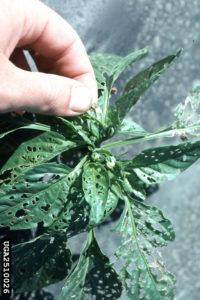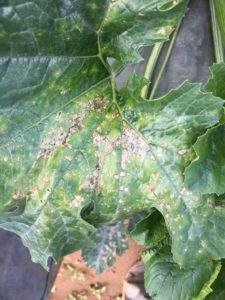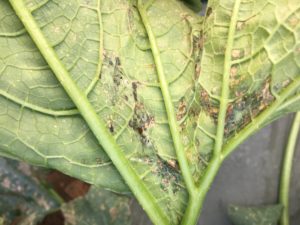Sweet Corn
European corn borer (ECB) adults have all but disappeared over the past week, and no map will appear in this edition. Larval infestations are sparse now, as the last corn plantings to be exposed to ECB in the whorl now have entered the silk stage.
The highest nightly trap catches of ECB for the week ending 7/15/20 are as follows:
| Califon 1 | Eldora 1 |
| Cinnaminson 1 | Old Bridge 1 |
| Crosswicks 1 | Tabernacle 1 |
 Fall armyworm (FAW) has declined, and larval infestations are no longer evident in the northern counties. There are still low infestations in Cape May County, and moths are being captured there as well as near the Burlington/Camden County border. This is the time of the summer when FAW can show up, resulting in significant injury to whorl and even seedling stage corn. Injury from newly hatched larvae shows up as “window panes” or areas where leaf tissue has been eaten down the the lower epidermis (see photo at left). This injury leads down into the whorl. As larvae gain size, they begin to consume leaf tissue in its’ entirety, creating ragged holes and lots of droppings (see photo at right). FAW can be tough to manage because it is resistant to synthetic pyrethroid insecticides (IRAC 3A) and because larvae are often covered by their own droppings, making contact with the insecticide more difficult. Treat when 12% or more plants exhibit FAW injury alone, or in combination with ECB injury.
Fall armyworm (FAW) has declined, and larval infestations are no longer evident in the northern counties. There are still low infestations in Cape May County, and moths are being captured there as well as near the Burlington/Camden County border. This is the time of the summer when FAW can show up, resulting in significant injury to whorl and even seedling stage corn. Injury from newly hatched larvae shows up as “window panes” or areas where leaf tissue has been eaten down the the lower epidermis (see photo at left). This injury leads down into the whorl. As larvae gain size, they begin to consume leaf tissue in its’ entirety, creating ragged holes and lots of droppings (see photo at right). FAW can be tough to manage because it is resistant to synthetic pyrethroid insecticides (IRAC 3A) and because larvae are often covered by their own droppings, making contact with the insecticide more difficult. Treat when 12% or more plants exhibit FAW injury alone, or in combination with ECB injury.
 Corn earworm (CEW) moth captures remained steady at reasonably low levels in blacklight traps this past week. Despite these lower counts, silking corn continues to require protection from this pest. Blacklight catches remain highest overall along the coast (see map at left).
Corn earworm (CEW) moth captures remained steady at reasonably low levels in blacklight traps this past week. Despite these lower counts, silking corn continues to require protection from this pest. Blacklight catches remain highest overall along the coast (see map at left).
The highest nightly trap catches of CEW in black light traps for the week ending 7/15/20 are as follows:
| Matawan 5 | Denville 1 | Farmingdale 1 |
| Centerton 1 | Downer 1 | Jones Island 1 |
| Clinton 1 | East Vineland 1 | Medford 1 |
| Crosswicks 1 | Elm 1 | Milltown 1 |
 CEW pheromone trap catches have also remained steady, with low-to-moderate catches mainly in the southern half of the state (see CEW pheromone map at left). Areas in white generally represent populations requiring 6-7 day spray schedules to manage, while blue areas are in the 5-6 day range. Green areas represent a 4-5 day schedule. The number of pheromone traps deployed is much lower, resulting in much broader color bands on the map. CEW activity in this network, however clearly indicates a highly variable but economically important population in the state at this time.
CEW pheromone trap catches have also remained steady, with low-to-moderate catches mainly in the southern half of the state (see CEW pheromone map at left). Areas in white generally represent populations requiring 6-7 day spray schedules to manage, while blue areas are in the 5-6 day range. Green areas represent a 4-5 day schedule. The number of pheromone traps deployed is much lower, resulting in much broader color bands on the map. CEW activity in this network, however clearly indicates a highly variable but economically important population in the state at this time.
The highest nightly trap catches of CEW in pheromone traps for the week ending 7/15/20 are as follows:
| Monroeville 8 | Berlin 6 | Crosswicks 3 |
| Pedricktown 8 | Elm 6 | Farmingdale 3 |
| Woodstown 8 | Springdale 4 | Green Creek 3 |
| Jones Island 7 | Beckett 3 | East Vineland 2 |
Silking Spray Schedules*:
South – 4-5 days
Central – 5-6 days
North – 6-7 days
*These recommendations are based on regional catches. Adhere to tighter spray schedules if indicated by local trap catches. Synthetic pyrethroids alone should NOT be used for corn earworm (CEW) protection on silking corn, or for fall armyworm (FAW) management at any stage. Control with these materials is very inconsistent.
Pepper weevil
Pepper weevil has now been trapped at two farms in southern New Jersey in the past week, one in the Vineland area and the other in the Pedricktown area. With the farms so widely separated, this likely represents two different source populations though it is difficult to determine how the weevils arrived at either farm.
As for control materials, Florida insecticide trials indicate that Actara, Vydate, Harvanta, and Torac provide the best results, however, there is a broad range of materials including pyrethroids and neonics that can kill the adults. The hope is to eliminate the weevil population before it becomes established in the field. A combination of spraying, trapping, and removal of aborted fruit would help to manage this pest.
If anyone wants pheromone traps or participate in a project of evaluating different lures, please contact Joe Ingerson-Mahar, mahar@sebs.rutgers.edu; phone: 856-889-5718.
 Pheromone trap catches of beet armyworm (BAW) are slowly increasing in parts of southern NJ, although there was a large catch this week in the Woodstown area (63/night). Although there have been no reports of larval feeding on peppers as yet, it is important to remember that this pest is capable of causing rapid and significant injury to pepper plants. Look for clusters of plants with lace-like damage to foliage near growing points (see photo at upper left). The green caterpillars will be found among these damaged leaves (see photo at lower left). After consuming foliage, BAW can begin to damage fruit directly. It is also important to note that BAW, like FAW, is resistant to synthetic pyrethroid insecticides. For this reason, materials in the IRAC 5 and 28 classes should be used in response to an infestation.
Pheromone trap catches of beet armyworm (BAW) are slowly increasing in parts of southern NJ, although there was a large catch this week in the Woodstown area (63/night). Although there have been no reports of larval feeding on peppers as yet, it is important to remember that this pest is capable of causing rapid and significant injury to pepper plants. Look for clusters of plants with lace-like damage to foliage near growing points (see photo at upper left). The green caterpillars will be found among these damaged leaves (see photo at lower left). After consuming foliage, BAW can begin to damage fruit directly. It is also important to note that BAW, like FAW, is resistant to synthetic pyrethroid insecticides. For this reason, materials in the IRAC 5 and 28 classes should be used in response to an infestation.
Pumpkins and Winter Squash
Note that Dr. Andy Wyenandt reports (Cucurbit Downy Mildew Update 7/06/20) that downy mildew (CDM) has been reported on cucumbers in Salem County. This is a clear indication that all growers of cucumbers and muskmelons should be scouting these crops every several days for signs of infection.
A cucurbit downy mildew sentinel plot at Snyder Farm in Hunterdon County has thus far remained free of CDM. This plot, consisting of pumpkin, watermelon, cantaloupe, butternut, acorn, cucumber and kabocha squash is used to indicate the presence of cucurbit downy mildew in the region, and what crops are affected. As of 7/15/20, there was no CDM detected in this plot. For regional information on this important disease, see the Cucurbit Downy Mildew Forecast webpage: http://cdm.ipmpipe.org/. As of this Tuesday (7/14/20), New Jersey was outside any area of risk for new infections by CDM.

 Some fields are now symptomatic for bacterial leaf spot. This infection begins as dark, “greasy” looking lesions on the upper leaf surface. These are dark on the underside of the leaf as well, but with age, turn pale and often fall out. Plants generally continue normal growth even with this disease, but developing fruit may be at risk, as bacteria drip from foliar lesions onto the fruit surface. This can result in pitting on the skin of the fruit, which can ultimately cause the fruit to rot. Consider the addition of copper hydroxide to the fungicide program that is initiated by the appearance of powdery mildew as fruit begin to size.
Some fields are now symptomatic for bacterial leaf spot. This infection begins as dark, “greasy” looking lesions on the upper leaf surface. These are dark on the underside of the leaf as well, but with age, turn pale and often fall out. Plants generally continue normal growth even with this disease, but developing fruit may be at risk, as bacteria drip from foliar lesions onto the fruit surface. This can result in pitting on the skin of the fruit, which can ultimately cause the fruit to rot. Consider the addition of copper hydroxide to the fungicide program that is initiated by the appearance of powdery mildew as fruit begin to size.
Tomatoes
 Tomato fruitworm (CEW) are still occasionally found in green fruit in high tunnel and field tomatoes in Hunterdon County, although infestation rates are well below 1% and no small (very recent) larvae have been detected. While this is typically a late summer occurrence, it is important that growers check plantings that have fruit present for infestation s of this pest. High tunnels do not offer protection from CEW or other caterpillar pests of tomato. CEW moths will lay eggs on the uppermost flower clusters. As these eggs hatch, larvae will bore into fruit in the upper and outer canopy (see photo at left). While infestations at this time may not result in significant fruit loss, actual losses are somewhat unpredictable. If tomato fruitworm infestations are found at 3 or more sites in a 10 site sample in the field, or in more than one site in a 5 site sample (as in a high tunnel), it may be time to apply an insecticide to limit further damage, especially if CEW moths are still being captured in local traps. A complete list of insecticides for this pest may be found in the Tomato Section of the Commercial Vegetable Production Recommendations. Note that the insecticide Entrust is OMRI approved. Avoid applying insecticides that carry a “M” or “H” designation for bee toxicity while bees are active in the field.
Tomato fruitworm (CEW) are still occasionally found in green fruit in high tunnel and field tomatoes in Hunterdon County, although infestation rates are well below 1% and no small (very recent) larvae have been detected. While this is typically a late summer occurrence, it is important that growers check plantings that have fruit present for infestation s of this pest. High tunnels do not offer protection from CEW or other caterpillar pests of tomato. CEW moths will lay eggs on the uppermost flower clusters. As these eggs hatch, larvae will bore into fruit in the upper and outer canopy (see photo at left). While infestations at this time may not result in significant fruit loss, actual losses are somewhat unpredictable. If tomato fruitworm infestations are found at 3 or more sites in a 10 site sample in the field, or in more than one site in a 5 site sample (as in a high tunnel), it may be time to apply an insecticide to limit further damage, especially if CEW moths are still being captured in local traps. A complete list of insecticides for this pest may be found in the Tomato Section of the Commercial Vegetable Production Recommendations. Note that the insecticide Entrust is OMRI approved. Avoid applying insecticides that carry a “M” or “H” designation for bee toxicity while bees are active in the field.

 Two-spotted spider mites (TSSM) are becoming a more common occurrence in tomato fields now that warm weather has dominated for some time. These pests can build to high populations quickly and are a particular nuisance in high tunnels. Check two complete leaves each on 5 consecutive plants in 10 random locations in a planting. Look for the characteristic mite “stipple”, or whitish pin spots on the upper surface of the leaf (see photo at left). A check of the underside of the leaf should reveal the actual mites (photo at right). Be sure to take some samples from field or tunnel edges as this is often from where TSSM will enter the planting. Consider an miticide application if TSSM are found at more than one site in the sample. Miticide choices are found in the Tomato Section of the Commercial Vegetable Production Recommendations.
Two-spotted spider mites (TSSM) are becoming a more common occurrence in tomato fields now that warm weather has dominated for some time. These pests can build to high populations quickly and are a particular nuisance in high tunnels. Check two complete leaves each on 5 consecutive plants in 10 random locations in a planting. Look for the characteristic mite “stipple”, or whitish pin spots on the upper surface of the leaf (see photo at left). A check of the underside of the leaf should reveal the actual mites (photo at right). Be sure to take some samples from field or tunnel edges as this is often from where TSSM will enter the planting. Consider an miticide application if TSSM are found at more than one site in the sample. Miticide choices are found in the Tomato Section of the Commercial Vegetable Production Recommendations.
Brown Marmorated Stink Bug
 Brown marmorated stink bug (BMSB) activity continues to be recorded in blacklight traps, and catches are heavier in southern New Jersey. While this pest has generally declined as a threat to peppers, it remains a significant threat to tree fruit.
Brown marmorated stink bug (BMSB) activity continues to be recorded in blacklight traps, and catches are heavier in southern New Jersey. While this pest has generally declined as a threat to peppers, it remains a significant threat to tree fruit.
The highest nightly catches of BMSB in black light traps for the week ending 7/15/20 are as follows:
| Downer 15 | Allentown 4 | Centerton 2 |
| Farmingdale 9 | Green Creek 4 | Chester 2 |
| Crosswicks 8 | Hillsborough 4 | Medford 2 |
| Cinnaminson 5 | Clinton 3 | New Egypt 2 |


